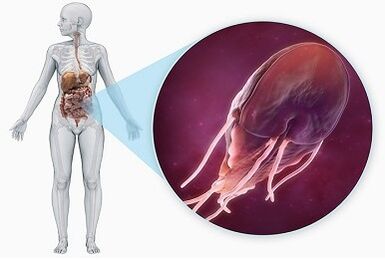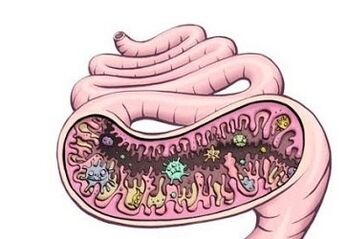Parasitism is a form of interspecific interactions in part or completely existed by another type of representative (parasitia) representative. The taxonomic list of parasitic forms affecting a person is extremely wide

Parasites are found in arthropods, mollusks, worms, fungi, simple organisms, and this is not a list. Medically patrous bacteria and viruses are parasites.
In this article, we will talk about the parasitic forms of the Property Kingdom (Protozoa). Parasites are always an unpleasant and undesirable phenomenon, so you need to know as much as possible about them to fight them effectively.
Representatives of the Kingdom are often called uniform organisms. These are the creatures that are only one cell that has a constant shape or cytoplasmic movements such as ciliates or cyotoplasmic movements, such as ciliates or amoeba.
It is equipped with many protozoa, flagella, cilia or moving bodies represented in pseudopod. Their sizes are waving several millimeters from the microscopic. The organism has a organelle set that performs similar functions similar to the bodies of more complex organisms.
The kingdom is represented by about 15, 000 species, most of them live in a water and soil environment.
However, there is part of a cellular body that prefers a parasite lifestyle. One person's simplest parasites can cause a disease like Protozoans - sometimes resulting in death to severe forms. It is sometimes very difficult to get rid of the parasites in the body.
Protooz has a protective mechanism - transferring environmental conditions in a non-dormant situation. The cell is covered with a tight, impassable shell, cysts becomes and can be very long in a form that is not so much. Incest is also used by the simplest to distribute them.

The simplest people of a person are different in the structure, the method of accessing the body and cause diseases. For the best structure of the information, the main material of a cellular organism is presented in the table as soon as possible.
| The class is flagged | |||
|
Leather Leishmanosis is characterized by the formation of necrotic Ülkers in the affected areas of the skin. Visaleral Leishmanosis leads to sharp inflammatory reactions with affected organs, ulcer and bleeding. | They fall into the bloodstream with a mosquito bite with saliva. Carriers - people, including hot-blooded animals; The carrier is a mosquito. | Promasticegote (body form). |
|
Enterit, allergy, asthma, depression, nerve disorders, cracks, dry skins, cholecysticine, etc. | The faeces of infection through food and water. Carriers - people, including hot-blooded animals; Carriers - Sinanthropropic insects (flies, cockroaches). | Phase of cysts. |
|
Walking, burning in the genital area, discomfort during urine, non-healthy discharge from the genitalia. Complications are possible with infertility development. | Sexual way of infection; from the mouth; through the rectum; while inhalation; It is possible to transfer parasites to the child born during childbirth. A carrier and carrier are a person. | Any stage of life cycle: Flagellellates (adults), amoeboid (intermediate, invasive), cyst. |
|
In the lymph nodes, the increase in pathological processes in the liver of the spleen, is characterized by extreme drowsiness and a fatal result is often. The disease is developing up to two years. | Insect enters blood flow during insect bite with saliva; While spilling blood. People, including the carrier hot-blooded animals, a carrier - Tseche (African throdomosis), a tritical error (American trofanocomomes). | Trypomastigegote stage (the ability to lay and move membrane). |
| SPORES Class | |||
|
The secret and chronic form continues asymptomatic; Symptoms of a sharp form show herself from affected organs. The most dangerous for pregnant women and newborns, causes serious disorders and congenital pathologies to the death of the fetus. | Unprocessed milk, faeces and oral of infection through meat; with insect bites; During pregnancy until the birth of a child. Attacks and carriers are hot animals, including people. | Phase of cysts. |
|
Increasing body temperature, temperature, fever, kidneys can cause serious lesions, a nervous system, a fatal result. | A person enters a person's blood flow during a bite with an insect saliva; passes during pregnancy until the birth of a child; While spilling blood. The carrier is a man, a carrier is a malaria mosquito. | Stage of sporosuits (the final form of the sexual period of spores). |
| Infusorian class | |||
|
The ulcer of the mucous membrane of the large intestine is accompanied by blood and the deadly result often occurs. | Faeces and oral of infection through fruit, vegetables, unprocessed pork. A carrier pig, a carrier - Sinanthropis insects (flies, cockroaches). | Phase of cysts. |
| Sarcods Class | |||
|
Organizes the form of asymptomatic and demgrtrative disease. Intestine Amoebiasi shows itself with bloody diarrhea and vomiting; The extra spoiled amoebiasis is characterized by the drastic lesions of the liver, lungs and other organs. | Faeces of infection via vegetables, fruits, greens; Anal sex. The carrier are hot-blooded animals, most people, carriers, carriers - Sinanthropis insects (flies, cockroaches). | Quad -core cysts stage. |
As a rule, it is characterized by a very complex and very complex and multi-level life cycle for all protozoa, a very complex and multifaceted life cycle, which includes a different shape, action rate and functional stages.
Regular organisms often occur by a simple cell department, but in addition to some classes, section, a more complex reproductive process related to the representatives of the Flagella class.
In addition, the forms of life forms of protozo are not universal for all classes. The various stages of the life cycle of the parasites may occur in the organisms of different types of animals.

Thus, some play the role of permanent owners, parasite carriers and others. In addition, the individual stages of the life cycle can occur in the same individual, but in different bodies.
The symptoms of the occupation depend on the life cycle of the parasite, the human body in the resistance, infection and localization. Often the disease is accompanied by non-power symptoms, the result is always very difficult to diagnose infection with protozoa.
According to the latest data, more than 1 billion people are infected in the parasite. The worst thing, the detection of parasites is extremely difficult.
- annoyance, weakness, drowsiness;
- often headache;
- Itching, allergic reactions;
- Terrority in the mouth, teeth and tongue;
- change in body weight;
- Diarrhea, constipation and pain in the stomach;
- The escalation of chronic diseases.
All this is the signs of the parasites in your body. Parasites can be very dangerous, cause fatal diseases. Diseases caused by parasites are a chronic shape.


















